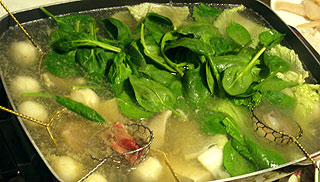It's the Year of the Fire, or Golden, Pig, and while more
traditional Chinese New Year meals can be had, my family likes to customize
things by having fire pot, a.k.a. hot pot (huo guo in Mandarin).
Variations abound, but essentially the meal comprises a cauldron of boiling
broth (often chicken combined with pork) and a wide array of raw foods that are
cooked in the broth at the table. The traditional method calls for a special
hollow-centered pot set atop burning charcoal embers, hence the name. Modern
gadgets give us convenience in an electric skillet (or two).

On our table each year is a celebratory palette of fresh shrimp, fish balls,
thinly sliced fish, paper-thin beef rib eye and pork shoulder, slabs of pale
tofu, ribbons of squid, chunks of napa cabbage, baby spinach, and lengths of
cellophane noodles (for longevity). Raw food is placed in a little mesh basket
to keep the loot from floating away and to control cooking (I like my beef barely
cooked and my fish barely opaque). Each of us has a small vessel of raw beaten
egg flavored simply with just soy sauce or adorned with condiments including
the ever-present chile paste with garlic, Chinese barbeque sauce (no smoke
here), red chile oil, black vinegar, etc. Cooked food is dipped into the egg
mixture, then eaten. The remaining liquid transforms into a flavorful broth for
the finish. It's truly made to order—by you. So if dinner is lousy, it's your
own fault.




 Pinterest
Pinterest


